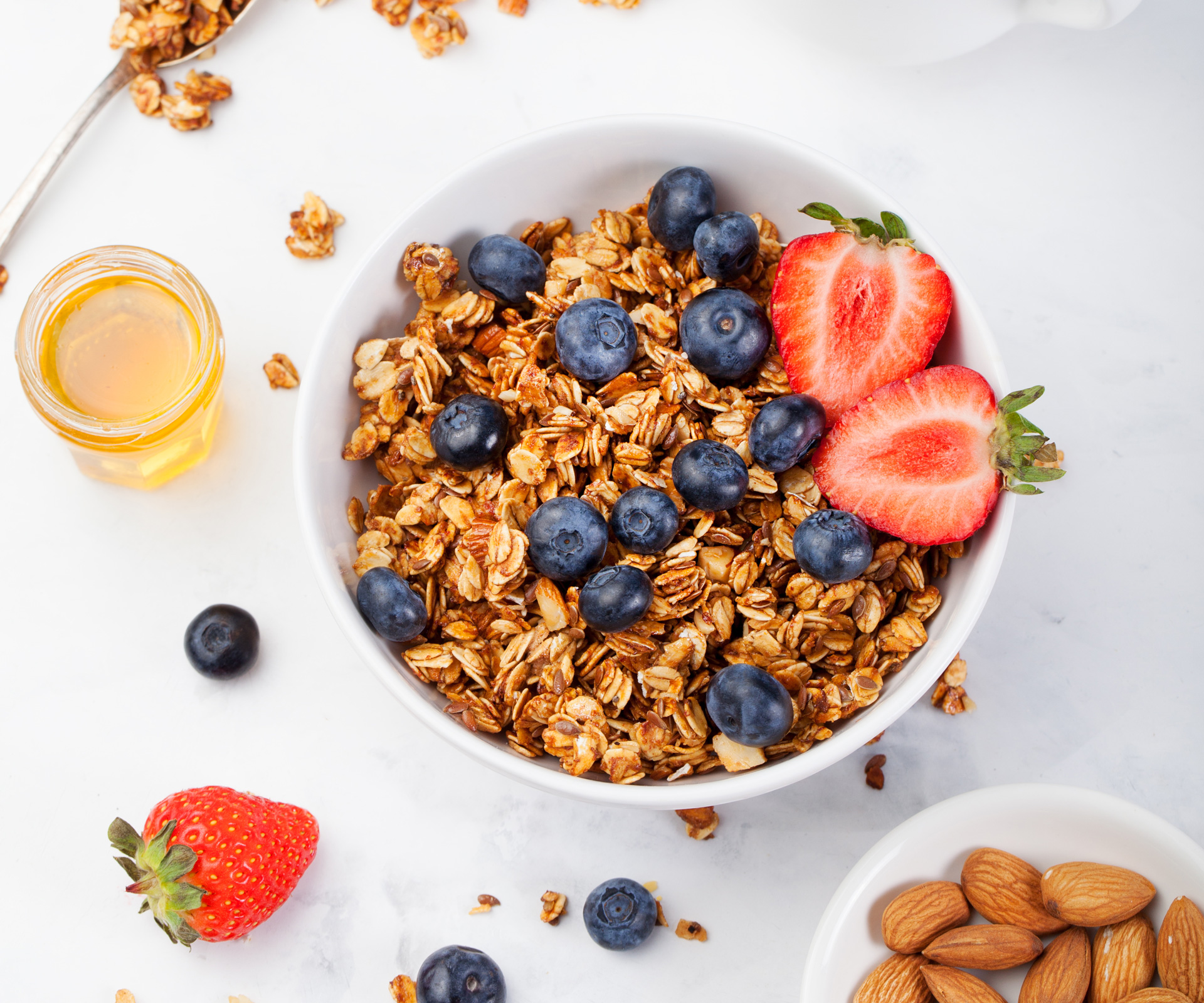As we learn more about gut health, weight management and disease prevention, the more important dietary fibre seems to become for our wellbeing.
Here experts share how we can up our fibre intake and make the most of it for our health.
With the expanding evidence-based health research on dietary fibre it’s proving vital to incorporate a range of fibres into our diet, as different types provide different benefits to our many body systems.
“Dietary fibre, also known as roughage, is the indigestible component of plant foods, meaning our bodies are unable to break it down or have it be absorbed by our intestines, leaving it to bind with our systems waste products and eliminated through the proper channels,” explains accredited practising dietician Bec Norris.

It’s vital to include different kinds of fibre into your diet. (Image: Getty)
Traditionally, dietary fibre is classified as either soluble, which dissolves in water or insoluble, which doesn’t.
As the connection between fibre and digestive bacteria has unfolded, however, fermentable fibre has increasingly come to be seen as important for our health.
“Soluble fibre, which comes from structures within the cells of the plant, draws water into the gut, turning it into a gel-like substance that slows down how quickly food is digested and the stomach empties,” says Bec.
Foods rich in soluble fibre include legumes, apples, avocados, sweet potatoes, broccoli, sunflower and chia seeds, oats and figs.
“Insoluble fibre, comes from the hard structural part of a plant, and attracts water into the stool, making it softer, bulkier and easier to pass, and has a general ‘sweeping’ effect throughout the bowel,” adds Bec.
Foods high in insoluble fibre include wholegrain breads, quinoa, cereals, nuts, seeds, skin of fruits and veges, cauliflower, kale, chickpeas, wheat bran and potatoes.
Fermentable fibre, often called prebiotics, is fibre that only friendly gut bacteria are able to digest or ferment and use as fuel.
“Because human cells don’t have the enzymes to digest fermentable fibre, these fibres reach the large intestine intact, where intestinal microbes do have the required enzymes to do so, feeding in this way the ‘good’ bacteria and providing a favourable environment for the growth of healthy gut flora,” says Bec.
Foods rich in fermentable fibre include barley, oats, leeks, yams, onions, garlic and bananas.
As each type of dietary fibre contributes to wellness in its own way, let’s look where it has the most impact.

Oats are rich in fermentable fibre. (Image: Getty)
High-fibre foods promote hormonal balance
High-fibre foods tend to be lower on the glycaemic index than refined carbs, reducing the likelihood of blood-sugar spikes and other hormonal imbalances.
“If your blood-sugar levels are high, the hormone insulin is secreted into your cells in order to lower the amount of glucose circulating in your bloodstream. This has been linked to higher oestrogen levels,” explains naturopath Chantelle Bell.
“But foods high in insoluble fibre will balance blood sugar levels by slowing down their release into our bloodstream,” says Chantelle.
“In instances of excess oestrogen levels, the same fibre will also support the liver to detox fat-soluble waste related to oestrogen, and can also allow ovulation to occur in instances when ovulation doesn’t occur.”
Studies have linked high-fibre foods, mainly from veges, to a reduced risk of breast cancer, likely mediated by the effect of fibre on lowering circulating oestrogen levels.
Chronically high cortisol levels can suppress hormone production, but again fibre can help.
Chantelle says, “Soluble fibre supports healthy levels of bacteria in the gut, suppresses the release of cortisol during a stressful period and this helps regulate oestrogen dominance.”
You can control your weight with fibre
Diets high in fibre make it much easier to reach and maintain a healthy weight.
“Soluble fibre in the diet slows down how quickly we digest our food, which results in leaving us feeling fuller for longer, making our weight loss and weight control goals achievable,” says Chantelle.
Research published in Nutrients tested the effects of a processed-meat and cheese meal against a plant-based meal with tofu on gastrointestinal hormones and satiety in men with type 2 diabetes.
It found an increase in gut hormones and satiety in those who ate the plant-based meal.
A 2015 study also suggested that something as simple as aiming to eat 30g of fibre each day could help you lose weight, lower your blood pressure, and improve your body’s insulin response as effectively as a more complicated diet.

Apples are a source of both soluable and insoluable fibre.
Our liver thrives off high-fibre foods to remove toxins
The liver, our major detoxification organ, thrives off high-fibre foods to remove toxins, fats and fat-soluble waste.
“As long as we eat adequate amounts of soluble fibre, fat-soluble waste from the bloodstream binds with bile from the liver in the small intestine and is eliminated,” explains clinical nutritionist Alexandra Handreck.
On the other hand, if we’re eating a low-fibre diet, bile produced by the liver is recirculated in our system, instead of being ushered out of the body and subsequently replaced with fresh bile by the liver.
The importance of consuming natural plant sources of fibre through wholefoods was highlighted by the University of Toledo, which discovered that adding refined soluble fibre to enrich processed foods, could induce liver cancer in mice – and researchers made it clear that it has potential implications for human health too.
Fibre supports better gut health

It’s a good idea to increase the amount of fibre in your diet gradually to avoid constipation, bloating and gas. (Image: Getty)
Resistant starch, a unique type of fibre that functions like soluble and fermentable fibre, can boost gut and brain health.
“Resistant starch – found in under-ripe bananas and cooked and cooled potatoes and rice – is a type of starch that ‘resists’ digestion and, just like fermentable fibre, bypasses the small intestine to reach the large intestine relatively intact,” says Alexandra.
“Once there it ferments, acting as a prebiotic, allowing friendly bacteria to feed off it, resulting in healthy gut microbes. In turn, this fermentation process produces key metabolites, most importantly short-chain fatty acids, which are the main source of energy for the cell lining of our colon, reducing the risk of colorectal cancer and gut inflammation, and improving immune function.”
Research published in the American Journal of Clinical Nutrition found that simply adding a healthy fibre-enriched snack bar to our daily diets could swing microbial profiles in a matter of weeks.
Another recent study, published in Frontiers in Immunology, suggested that eating more soluble fibre could mean less cognitive decline and memory loss with age, and a decreased risk of neuro-degenerative diseases, as a result of short-chain fatty acids exerting anti-inflammatory properties.
People who eat higher levels of fibre have lower rates of non-communicable diseases
New research published in The Lancet, which looked at clinical trials conducted over nearly 40 years, confirms that people who eat higher levels of dietary fibre and wholegrains have lower rates of non-communicable diseases compared with those who eat less.
With the growing consensus that chronic inflammation is behind many common diseases, the anti-inflammatory capacity of healthy gut bacteria as a result of dietary fibre is even more crucial in disease prevention.
A Finnish Diabetes Prevention study showed that people who ate more fibre had higher levels of an anti-inflammatory chemical in their blood and were also less likely to develop type 2 diabetes.
Other studies have identified C-reactive protein (CRP) a marker of inflammation, to be lower in the blood levels of people who eat a high-fibre diet.
Other research found that eating more fibre may help prevent rheumatoid arthritis and build stronger bones. Specifically, it’s the production of short-chain fatty acids that supports bone density, and can help treat rheumatoid arthritis and post-menopausal bone loss.
“Fibre helps in increasing calcium absorption which is beneficial for those predisposed to osteoporosis,” says Alexandra.

Wholegrain breads, quinoa and cereals are high in insoluable fibre.
How to increase your fibre intake safely
“Having too much fibre too quickly with not enough water and movement can result in constipation, bloating and gas,” says Bec.
“Therefore, it’s a good idea to increase the amount and variety of fruits, vegetables and wholegrains gradually over a four to six-week period, until you reach a total fibre intake of 30g.”
Remember to also increase water intake and movement as you go.
 Getty Images
Getty Images

